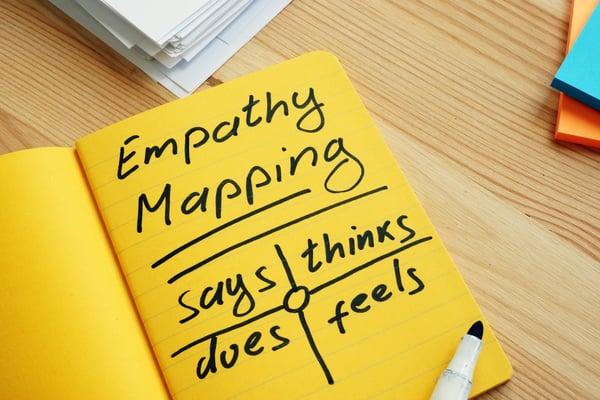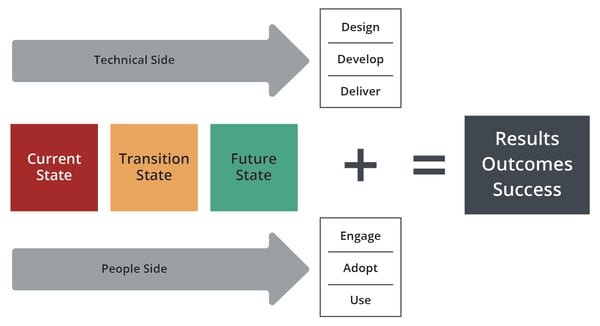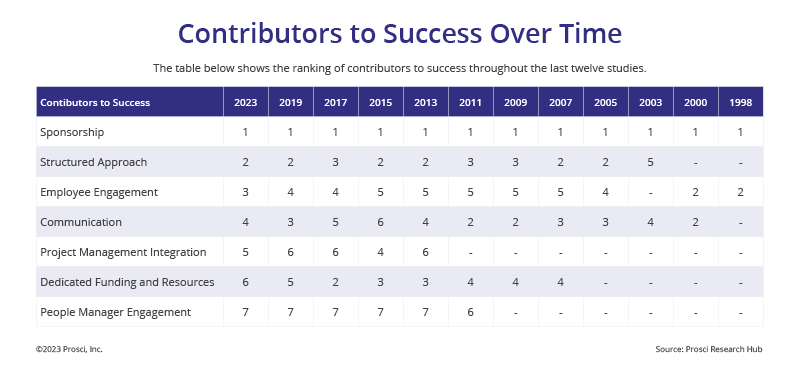How Empathy Mapping Helps When Redeploying Workers

4 Mins
Updated: November 20, 2024
Published: March 1, 2023

Redeploying workers into new roles is an increasingly common challenge for change practitioners, and it often happens during a crisis. But no matter how urgently a change is needed, designing and implementing solutions without understanding the people they impact will ultimately diminish their desire to adopt and use those solutions, which is essential to your success. Empathy helps you balance the technical and people sides of change while gaining valuable insights about impacted people and their personal struggles.
Empathy and Wearing Another’s Shoes
Empathy is the ability to understand what another person is experiencing―to try to see the issues from their unique perspective. Unlike sympathy, empathy is about trying to feel what others are feeling.
The extreme nature of urgent changes, such as those brought about by the COVID-19 pandemic, makes it easy to see why empathy is so important. Aside from risks associated with the illness itself, people were concerned about the well-being of loved ones, the effects of social isolation, a volatile economy, and an uncertain future. Ongoing change was already becoming the norm in organizations, but it has since become an overpowering force in our personal lives. And the impacts have a profound effect on an individual’s Desire to adopt a critical change like moving to a new job role.
How Empathy Mapping Helps During Change
Empathy mapping is a collaborative visualization technique used to better understand people (or users or customers) to create a shared understanding of their needs and aid in decision making. A foundational step in the discipline of design thinking, empathy mapping enables you to put yourself in the shoes of the people for whom you are designing the solution. The idea is that immersing yourself directly into their experience will evoke empathy for those people.

Empathy maps are a quick way to “get inside a person’s head.” Each quadrant of the map represents the individual or group and how they relate to a particular change. Working through each quadrant helps you connect with the individual or group, distill critical information, and promote widespread understanding.
Many online resources exist if you want to learn more about empathy maps and empathy mapping techniques. The technique you choose is less important than understanding the ways empathy mapping can help you as change practitioners and organizational leaders during crisis-related change:
1. Appropriately balancing the technical side and people side of change
This is the user-centered design of the solution. At Prosci, we talk about change along two value streams. The first is the technical-side or what is being designed, developed and delivered. It’s the actual solution to a change challenge. The second is the people side or who must engage, adopt and use the solution so you can realize the desired benefits. Of course, the change management discipline focuses on the people side of change, but that doesn’t mean you should shy away from engaging on the technical side, especially during crisis-related change.

Designing solutions expediently may be the top priority today. But if you don’t focus on the impacted people who must adopt and use the solution, the quickly designed solution may not be adopted and never achieve the desired outcome. Conducting an empathy mapping exercise during solution design can help you look beyond your assumptions and enable you to see things from the perspective of impacted individuals and groups, which results in more adoptable solutions.
Empathy mapping can also aid decision making. Imagine the current challenge of redeploying workers into new roles. From an organizational perspective, you can move the boxes around on an organization chart, but an empathy mapping exercise may highlight the best way to optimize the way people work if you first understand their needs.
2. Involving people in the solution design and implementation challenges
Senior leaders often feel like they must have all the answers but involving people who represent impacted groups will introduce a unique perspective. Having a seat at the table gives them a voice and unites everyone around a common goal. Empathy mapping their needs, and those of the impacted groups they represent, helps proactively address resistance to change before the behaviors emerge. You can take this a step further by involving those people directly impacted by crisis-related change in the solution design and implementation.
In Prosci’s Best Practices in Change Management research, employee engagement and participation is the number three greatest contributor to change success behind active and visible sponsorship, using a structured change management approach, and communication. When redeploying workers into new roles, people who represent the impacted groups can provide ideas and feedback. They can become change champions, even though there may be little or no “what’s in it for me (WIIFM).” Their engagement can help promote a new mindset around “what’s in it for us (WIIFU).” And this team of change champions can carry the message to others in an honest and transparent way.
3. Recognizing that crisis-related change is often very personal
No matter how proactive you are at empathy mapping to support user-centered design and participation when designing and implementing solutions, change is individual. Resistance to change is natural. In a crisis, change can be very personal, which heightens resistant behaviors. Being mindful of organizational concerns is difficult while being consumed with individual concerns such as family impact, job loss or health concerns. The technical solution brought forward for the organization’s benefit may be the only way out of the challenge, even though it impacts individuals and teams negatively.
Empathy mapping gives individuals a way to organize, visualize and perhaps vocalize what they are thinking and feeling, so they can move past the personal impacts and toward collective change success. Helping everyone identify their own resistance response puts control in their hands at a time when they may feel like everything else is out of their control. For example, I may not be able to control how I am redeployed within my organization, but I can control how I respond to that change. Feeling like I am heard and understood by my manager and senior leaders in the organization may soften the fear and discomfort of the change and allow me some psychological safety amid crisis-related change.
The ADKAR Model and Empathy Mapping
Prosci’s ADKAR Model comprises five sequential building blocks: Awareness, Desire, Knowledge, Ability and Reinforcement. To build Desire and reduce change-resistant behaviors when redeploying employees into new roles, empathy mapping can help you make a positive impact. That’s important. Some rules go out the window during crisis-related change but treating people with empathy doesn’t have to be one of them.



